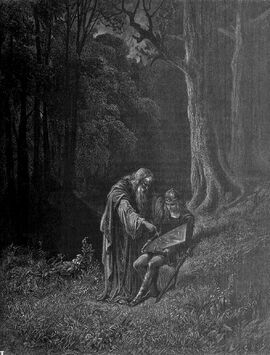
Merlin paints the young knight's shield by Gustave Dore, late 1800s.
Wynebgwrthucher was the name given to King Arthur's shield in the 11th century Welsh prose work, Culhwch and Olwen. The shield and Arthur’s weapons are named when Arthur says to Culhwch:
You shall have the request that head and tongue name, as far as the wind dries, as far as the rain wets, as far as the sun rises, as far as the sea stretches, as far as the earth extends, excepting only my ship, my mantle, my sword Caledfwlch, my spear Rhongomyniad, my shield Wynebgwrthucher, my knife Carnwennan and my wife Gwenhwyvar.
It is likely that this shield would be circular like those carried by Dark Age warriors rather than the elongated shields of later medieval warriors. Wynebgwrthucher means 'face of evening'. Some theorise that the shield bore an image of the cross. This originates from the Annales Cambriae (Welsh Annals) entry in which it is possible that the Welsh word for 'shield' has been confused with 'shoulder'. The Battle of Badon, in which Arthur carried the Cross of our Lord Jesus Christ for three days and three nights on his shoulders/shield (?) and the Britons were the victors.
Others believe it would have had an image of the Virgin Mary on it. This is line with the Historia Brittonum entry (possibly written by Nennius) which states: The eighth battle was in Gunnion fort, and in it Arthur carried the image of the Holy Mary, the everlasting Virgin, on his shoulders/shield (?) and the heathen were put to flight on that day, and there was a great slaughter upon them, through the power of Our Lord Jesus Christ and the power of the holy Virgin Mary.
According to Geoffrey of Monmouth in his 12th century Historia regum Britanniae, Arthur's shield bore an image of the Blessed Mary, Mother of God. But strangely, Geoffrey names the shield as Prydwen (or Pridwen) meaning 'fair face'. However, in the Preiddeu Annwfn (Spoils of Annwfn), a Welsh poem from the Book of Taliesin, Prydwen was the name given to Arthur's ship. Norris J. Lacy suggests that this poem, on the basis of linguistic criteria, took its present form around 900 AD. This is more than 200 years before Geoffrey's assertion that Pridwen was Arthur's shield. Additionally, also prior to Geoffrey's work, in the 11th century Culhwch and Olwen, Arthur's boat 'Prydwen' is mentioned three times. It would appear that Geoffrey got his name for Arthur's shield confused.
